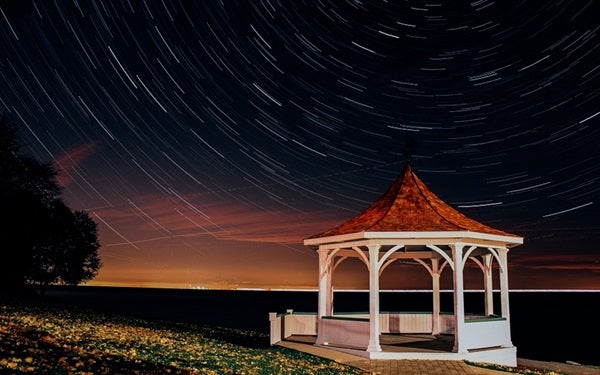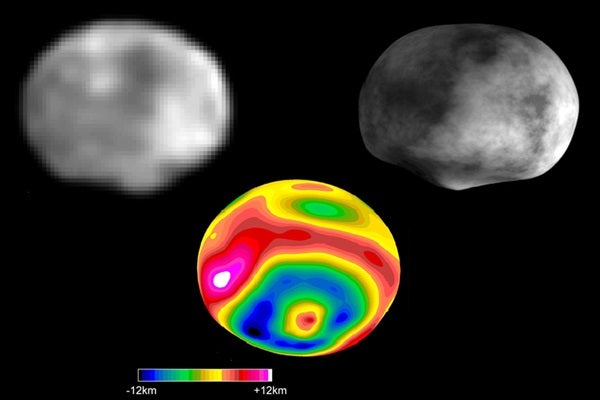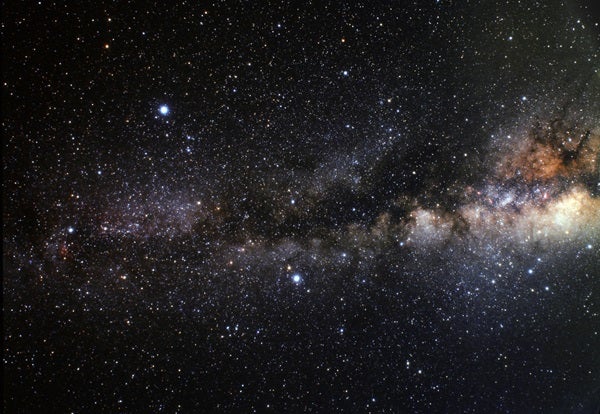Friday, August 17
Venus lies 46° east of the Sun today, its greatest elongation for this evening apparition. You might think the planet would likewise reach peak altitude today, but you’d be wrong — Venus stands only 7° high an hour after sunset. The problem is the ecliptic, the apparent path of the Sun across the sky that the planets follow closely, makes a shallow angle to the western horizon after the Sun goes down in late summer. How much difference does this make? Venus stood more than twice as high in early June when it was only 35° from the Sun. Still, the planet shows some distinct advantages over its late spring appearance. Not only is it brighter now, at magnitude –4.5, but it also looks more pleasing through a telescope. This evening, Venus’ disk spans 24″ and appears half-lit.
A nearly half-lit Moon lies 7° to Jupiter’s upper left this evening. The two make an attractive pair from evening twilight until the planet sets shortly after 11 p.m. local daylight time. Jupiter shines at magnitude –2.0 all this week and dominates the southwestern sky as night falls. If you view the gas giant through a telescope, you’ll see spectacular cloud-top detail on its 36″-diameter disk.
Saturday, August 18
First Quarter Moon arrives at 3:49 a.m. EDT. Our satellite won’t rise until around 2 p.m. local daylight time, however, so observers in the Americas won’t see it precisely half-lit. As darkness falls this evening, the Moon appears 58 percent illuminated and resides some 10° to the upper right of the 1st-magnitude star Antares.
Sunday, August 19
Although the annual Perseid meteor shower peaked last week, it remains active until August 24. The rate drops below 10 meteors per hour this week, however, so observers will have to be vigilant to get a show. You’ll want to view from a dark-sky site after the waxing gibbous Moon sets (around 12:30 a.m. local daylight time today and 45 minutes later each subsequent morning). To tell whether a meteor is a Perseid or just a random dust particle burning up in Earth’s atmosphere, trace the streak’s path backward in the sky. If it intersects the constellation Perseus, the meteor belongs to the shower.
Monday, August 20
Asteroid hunters have a great opportunity to spot Vesta this week as it crosses one of the emptiest zones near the Milky Way’s heart. The minor planet resides in southern Ophiuchus, a few degrees northeast of the 3rd-magnitude star Theta (q) Ophiuchi. But the constellation provides an even better guide star tonight and tomorrow night. Vesta skims less than 10′ south of 5th-magnitude 51 Oph, and you can see it move relative to this star during a two-hour observing session.
Tuesday, August 21
The waxing gibbous Moon points the way to magnitude 0.3 Saturn this morning. The ringed planet lies about 3° to the left of our satellite as they descend toward the southwestern horizon. The pair sets shortly before 2 a.m. local daylight time. By the time evening rolls around, the two have separated — the Moon then stands 9° to Saturn’s left. The two reside among the background stars of northern Sagittarius, a region that climbs highest in the south between 9 and 10 p.m. If you target Saturn through a telescope, you’ll see the planet’s 18″-diameter disk surrounded by a dramatic ring system that spans 40″ and tilts 27° to our line of sight.
Wednesday, August 22
Look overhead around 10 p.m. local daylight time and your eyes will fall on the brilliant star Vega in the constellation Lyra the Harp. At magnitude 0.0, Vega is the brightest member of the prominent Summer Triangle asterism. The Triangle’s second-brightest star, magnitude 0.8 Altair in Aquila the Eagle, lies some 35° southeast of Vega. The asterism’s dimmest member, magnitude 1.3 Deneb in Cygnus the Swan, stands about 25° east-northeast of Vega.
Thursday, August 23
The Moon moves about 13° eastward every 24 hours, and tonight it pulls into Mars’ vicinity. As darkness falls, the Red Planet lies some 8° to the Moon’s lower right. Mars remains a beacon, shining at magnitude –2.3, and stands out despite the Moon’s proximity. When viewed through a telescope, the planet’s disk spans 22″ and should show some subtle surface details as the global dust storm continues to abate.
The Moon reaches apogee, the farthest point in its orbit around Earth, at 7:23 a.m. EDT. It then lies 252,119 miles (405,746 kilometers) from Earth’s center.
Friday, August 24
The constellations Ursa Major the Great Bear and Cassiopeia the Queen lie on opposite sides of the North Celestial Pole, so they appear to pivot around the North Star (Polaris) throughout the course of the night and the year. In late August and early September, these two constellations appear equally high as darkness falls. You can find Ursa Major and its prominent asterism, the Big Dipper, about 30° above the northwestern horizon. Cassiopeia’s familiar W-shape, which currently lies on its side, appears the same height above the northeastern horizon. As the night progresses, Cassiopeia climbs above Polaris while the Big Dipper swings below.
Mars continues to move westward relative to the background stars, and today it crosses the border from southwestern Capricornus into eastern Sagittarius. But its stay among the Archer’s stars won’t be lengthy. The planet reaches its stationary point on the 28th and will move back into the Sea Goat on September 1.
Saturday, August 25
Full Moon officially arrives at 7:56 a.m. EDT tomorrow morning, but it looks completely illuminated all night. You can find it rising in the east around sunset and then watch it climb high in the south by 1 a.m. local daylight time. It dips low in the west by the time morning twilight starts to paint the sky. The Moon lies against the backdrop of Aquarius the Water-bearer, but its bright glow nearly drowns out the faint stars in this constellation.
Sunday, August 26
Mercury makes an impressive appearance before dawn in late August. It reaches greatest elongation this morning, when it lies 18° west of the Sun and appears 10° high in the east 30 minutes before sunrise. The innermost planet shines at magnitude –0.2 and is the most conspicuous celestial object near the eastern horizon. A telescope reveals the planet’s disk, which spans 7″ and appears 43 percent lit.












